Sneha Kudugunta
(Mis)Fitting: A Survey of Scaling Laws
Feb 26, 2025



Abstract:Modern foundation models rely heavily on using scaling laws to guide crucial training decisions. Researchers often extrapolate the optimal architecture and hyper parameters settings from smaller training runs by describing the relationship between, loss, or task performance, and scale. All components of this process vary, from the specific equation being fit, to the training setup, to the optimization method. Each of these factors may affect the fitted law, and therefore, the conclusions of a given study. We discuss discrepancies in the conclusions that several prior works reach, on questions such as the optimal token to parameter ratio. We augment this discussion with our own analysis of the critical impact that changes in specific details may effect in a scaling study, and the resulting altered conclusions. Additionally, we survey over 50 papers that study scaling trends: while 45 of these papers quantify these trends using a power law, most under-report crucial details needed to reproduce their findings. To mitigate this, we we propose a checklist for authors to consider while contributing to scaling law research.
MiTTenS: A Dataset for Evaluating Misgendering in Translation
Jan 13, 2024



Abstract:Misgendering is the act of referring to someone in a way that does not reflect their gender identity. Translation systems, including foundation models capable of translation, can produce errors that result in misgendering harms. To measure the extent of such potential harms when translating into and out of English, we introduce a dataset, MiTTenS, covering 26 languages from a variety of language families and scripts, including several traditionally underpresented in digital resources. The dataset is constructed with handcrafted passages that target known failure patterns, longer synthetically generated passages, and natural passages sourced from multiple domains. We demonstrate the usefulness of the dataset by evaluating both dedicated neural machine translation systems and foundation models, and show that all systems exhibit errors resulting in misgendering harms, even in high resource languages.
MatFormer: Nested Transformer for Elastic Inference
Oct 11, 2023



Abstract:Transformer models are deployed in a wide range of settings, from multi-accelerator clusters to standalone mobile phones. The diverse inference constraints in these scenarios necessitate practitioners to train foundation models such as PaLM 2, Llama, & ViTs as a series of models of varying sizes. Due to significant training costs, only a select few model sizes are trained and supported, limiting more fine-grained control over relevant tradeoffs, including latency, cost, and accuracy. This work introduces MatFormer, a nested Transformer architecture designed to offer elasticity in a variety of deployment constraints. Each Feed Forward Network (FFN) block of a MatFormer model is jointly optimized with a few nested smaller FFN blocks. This training procedure allows for the Mix'n'Match of model granularities across layers -- i.e., a trained universal MatFormer model enables extraction of hundreds of accurate smaller models, which were never explicitly optimized. We empirically demonstrate MatFormer's effectiveness across different model classes (decoders & encoders), modalities (language & vision), and scales (up to 2.6B parameters). We find that a 2.6B decoder-only MatFormer language model (MatLM) allows us to extract smaller models spanning from 1.5B to 2.6B, each exhibiting comparable validation loss and one-shot downstream evaluations to their independently trained counterparts. Furthermore, we observe that smaller encoders extracted from a universal MatFormer-based ViT (MatViT) encoder preserve the metric-space structure for adaptive large-scale retrieval. Finally, we showcase that speculative decoding with the accurate and consistent submodels extracted from MatFormer can further reduce inference latency.
MADLAD-400: A Multilingual And Document-Level Large Audited Dataset
Sep 09, 2023Abstract:We introduce MADLAD-400, a manually audited, general domain 3T token monolingual dataset based on CommonCrawl, spanning 419 languages. We discuss the limitations revealed by self-auditing MADLAD-400, and the role data auditing had in the dataset creation process. We then train and release a 10.7B-parameter multilingual machine translation model on 250 billion tokens covering over 450 languages using publicly available data, and find that it is competitive with models that are significantly larger, and report the results on different domains. In addition, we train a 8B-parameter language model, and assess the results on few-shot translation. We make the baseline models available to the research community.
BUFFET: Benchmarking Large Language Models for Few-shot Cross-lingual Transfer
May 24, 2023Abstract:Despite remarkable advancements in few-shot generalization in natural language processing, most models are developed and evaluated primarily in English. To facilitate research on few-shot cross-lingual transfer, we introduce a new benchmark, called BUFFET, which unifies 15 diverse tasks across 54 languages in a sequence-to-sequence format and provides a fixed set of few-shot examples and instructions. BUFFET is designed to establish a rigorous and equitable evaluation framework for few-shot cross-lingual transfer across a broad range of tasks and languages. Using BUFFET, we perform thorough evaluations of state-of-the-art multilingual large language models with different transfer methods, namely in-context learning and fine-tuning. Our findings reveal significant room for improvement in few-shot in-context cross-lingual transfer. In particular, ChatGPT with in-context learning often performs worse than much smaller mT5-base models fine-tuned on English task data and few-shot in-language examples. Our analysis suggests various avenues for future research in few-shot cross-lingual transfer, such as improved pretraining, understanding, and future evaluations.
PaLM 2 Technical Report
May 17, 2023



Abstract:We introduce PaLM 2, a new state-of-the-art language model that has better multilingual and reasoning capabilities and is more compute-efficient than its predecessor PaLM. PaLM 2 is a Transformer-based model trained using a mixture of objectives. Through extensive evaluations on English and multilingual language, and reasoning tasks, we demonstrate that PaLM 2 has significantly improved quality on downstream tasks across different model sizes, while simultaneously exhibiting faster and more efficient inference compared to PaLM. This improved efficiency enables broader deployment while also allowing the model to respond faster, for a more natural pace of interaction. PaLM 2 demonstrates robust reasoning capabilities exemplified by large improvements over PaLM on BIG-Bench and other reasoning tasks. PaLM 2 exhibits stable performance on a suite of responsible AI evaluations, and enables inference-time control over toxicity without additional overhead or impact on other capabilities. Overall, PaLM 2 achieves state-of-the-art performance across a diverse set of tasks and capabilities. When discussing the PaLM 2 family, it is important to distinguish between pre-trained models (of various sizes), fine-tuned variants of these models, and the user-facing products that use these models. In particular, user-facing products typically include additional pre- and post-processing steps. Additionally, the underlying models may evolve over time. Therefore, one should not expect the performance of user-facing products to exactly match the results reported in this report.
A Loss Curvature Perspective on Training Instability in Deep Learning
Oct 08, 2021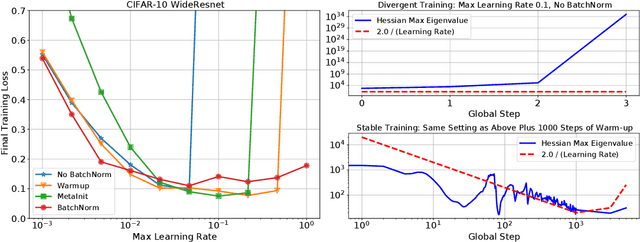

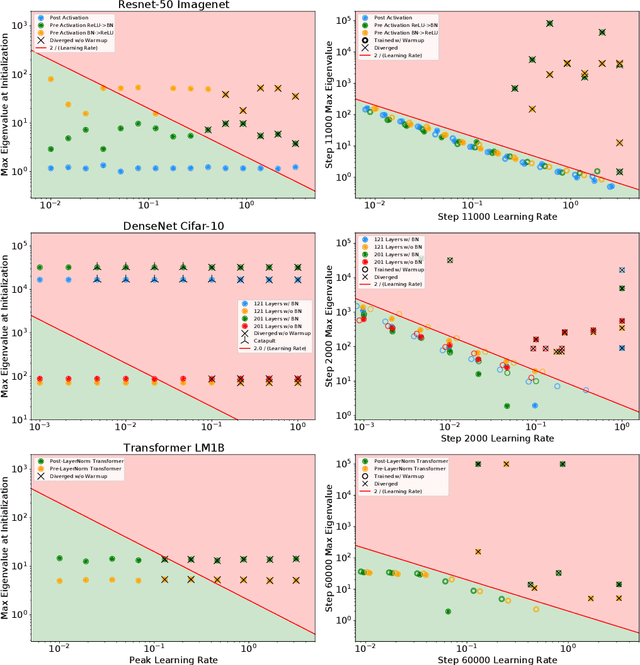

Abstract:In this work, we study the evolution of the loss Hessian across many classification tasks in order to understand the effect the curvature of the loss has on the training dynamics. Whereas prior work has focused on how different learning rates affect the loss Hessian observed during training, we also analyze the effects of model initialization, architectural choices, and common training heuristics such as gradient clipping and learning rate warmup. Our results demonstrate that successful model and hyperparameter choices allow the early optimization trajectory to either avoid -- or navigate out of -- regions of high curvature and into flatter regions that tolerate a higher learning rate. Our results suggest a unifying perspective on how disparate mitigation strategies for training instability ultimately address the same underlying failure mode of neural network optimization, namely poor conditioning. Inspired by the conditioning perspective, we show that learning rate warmup can improve training stability just as much as batch normalization, layer normalization, MetaInit, GradInit, and Fixup initialization.
Beyond Distillation: Task-level Mixture-of-Experts for Efficient Inference
Sep 24, 2021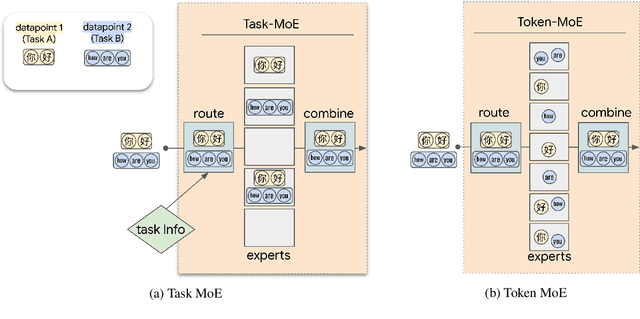
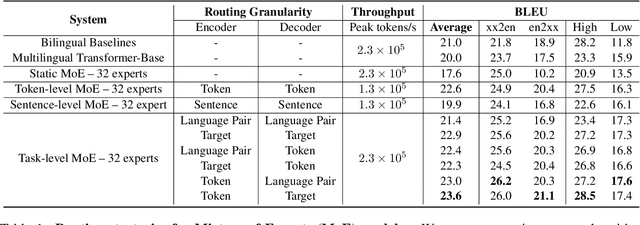
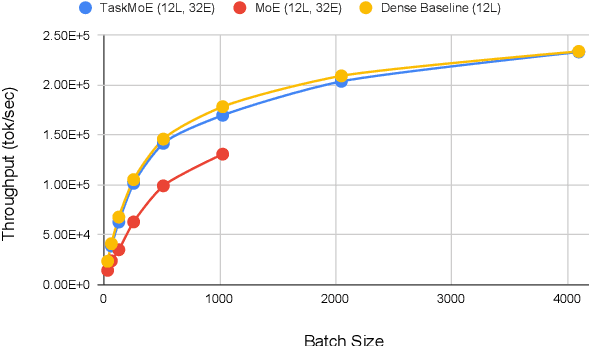

Abstract:Sparse Mixture-of-Experts (MoE) has been a successful approach for scaling multilingual translation models to billions of parameters without a proportional increase in training computation. However, MoE models are prohibitively large and practitioners often resort to methods such as distillation for serving. In this work, we investigate routing strategies at different granularity (token, sentence, task) in MoE models to bypass distillation. Experiments on WMT and a web-scale dataset suggest that task-level routing (task-MoE) enables us to extract smaller, ready-to-deploy sub-networks from large sparse models. On WMT, our task-MoE with 32 experts (533M parameters) outperforms the best performing token-level MoE model (token-MoE) by +1.0 BLEU on average across 30 language pairs. The peak inference throughput is also improved by a factor of 1.9x when we route by tasks instead of tokens. While distilling a token-MoE to a smaller dense model preserves only 32% of the BLEU gains, our sub-network task-MoE, by design, preserves all the gains with the same inference cost as the distilled student model. Finally, when scaling up to 200 language pairs, our 128-expert task-MoE (13B parameters) performs competitively with a token-level counterpart, while improving the peak inference throughput by a factor of 2.6x.
MURAL: Multimodal, Multitask Retrieval Across Languages
Sep 10, 2021



Abstract:Both image-caption pairs and translation pairs provide the means to learn deep representations of and connections between languages. We use both types of pairs in MURAL (MUltimodal, MUltitask Representations Across Languages), a dual encoder that solves two tasks: 1) image-text matching and 2) translation pair matching. By incorporating billions of translation pairs, MURAL extends ALIGN (Jia et al. PMLR'21)--a state-of-the-art dual encoder learned from 1.8 billion noisy image-text pairs. When using the same encoders, MURAL's performance matches or exceeds ALIGN's cross-modal retrieval performance on well-resourced languages across several datasets. More importantly, it considerably improves performance on under-resourced languages, showing that text-text learning can overcome a paucity of image-caption examples for these languages. On the Wikipedia Image-Text dataset, for example, MURAL-base improves zero-shot mean recall by 8.1% on average for eight under-resourced languages and by 6.8% on average when fine-tuning. We additionally show that MURAL's text representations cluster not only with respect to genealogical connections but also based on areal linguistics, such as the Balkan Sprachbund.
Quality at a Glance: An Audit of Web-Crawled Multilingual Datasets
Mar 22, 2021
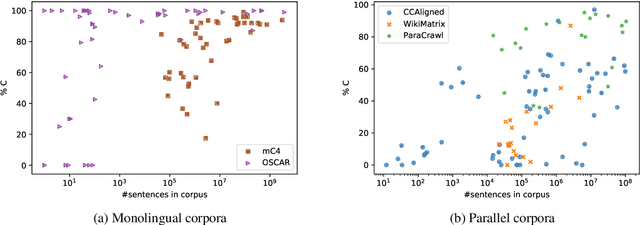
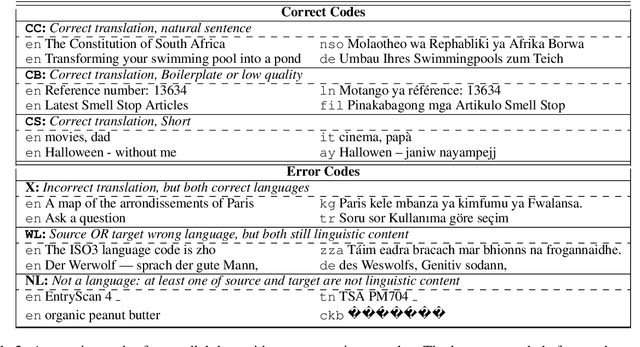
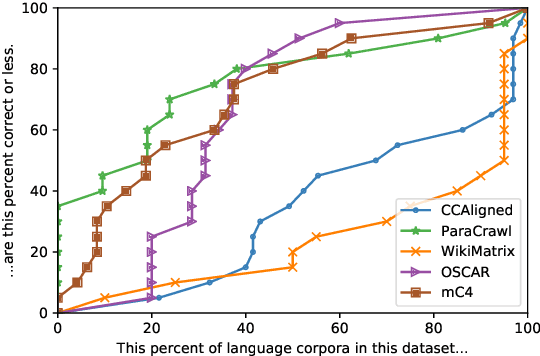
Abstract:With the success of large-scale pre-training and multilingual modeling in Natural Language Processing (NLP), recent years have seen a proliferation of large, web-mined text datasets covering hundreds of languages. However, to date there has been no systematic analysis of the quality of these publicly available datasets, or whether the datasets actually contain content in the languages they claim to represent. In this work, we manually audit the quality of 205 language-specific corpora released with five major public datasets (CCAligned, ParaCrawl, WikiMatrix, OSCAR, mC4), and audit the correctness of language codes in a sixth (JW300). We find that lower-resource corpora have systematic issues: at least 15 corpora are completely erroneous, and a significant fraction contains less than 50% sentences of acceptable quality. Similarly, we find 82 corpora that are mislabeled or use nonstandard/ambiguous language codes. We demonstrate that these issues are easy to detect even for non-speakers of the languages in question, and supplement the human judgements with automatic analyses. Inspired by our analysis, we recommend techniques to evaluate and improve multilingual corpora and discuss the risks that come with low-quality data releases.
 Add to Chrome
Add to Chrome Add to Firefox
Add to Firefox Add to Edge
Add to Edge